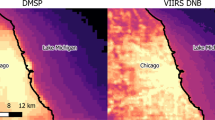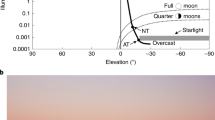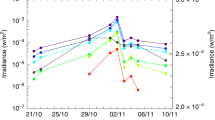Abstract
Images returned by the spacecraft Clementine have been used to produce a quantitative illumination map of the north pole of the Moon, revealing the percentage of time that points on the surface are illuminated during the lunar day. We have used this map to identify areas that are constantly illuminated during a lunar day in summer and which may therefore be in permanent sunlight. All are located on the northern rim of Peary crater, close to the north pole. Permanently sunlit areas represent prime locations for lunar outpost sites as they have abundant solar energy, are relatively benign thermally (when compared with equatorial regions), and are close to permanently shadowed regions that may contain water ice.
Similar content being viewed by others
Main
Because the Moon's spin axis is nearly perpendicular (about 1.5°) to the ecliptic plane, astronomers have long considered that areas of illumination extremes may exist near the lunar poles1. Topographic lows, such as the floors of impact craters, can be permanently in shadow2, whereas high areas could in theory be in constant sunlight. Permanently shadowed regions are extremely cold3 and may contain deposits of water ice4,5.
Conversely, the temperature in a permanently lit zone is relatively mild and constant because of the grazing insolation. The temperature at the lunar equator fluctuates from −180 °C to 100 °C, but the surface temperature for a constantly sunlit polar region has been estimated from modelling6 to be roughly −50±10 °C. A region with this relatively benign temperature range represents an attractive site for building hardware designed for long-term use.
The lunar north pole is in a highland region, in between three large impact craters7 — Peary (88.6° N, 33.0° E; diameter, 73 km), Hermite (86.0° N, 89.9° W; diameter, 104 km) and Rozhdestvensky (85.2° N, 155.4° W; diameter, 177 km). Because the pole lies just outside the crater rims, it is likely to be at a relatively high elevation, increasing the likelihood that some areas could be permanently illuminated. By contrast, the lunar south pole is just inside the rim of the South Pole–Aitken impact basin (2,500-km diameter), and there is no area at this pole that is constantly illuminated during the southern winter, as measured at the scale of the Clementine UVVIS data (500 m per pixel)8.
The Clementine spacecraft orbited the Moon in an elliptical orbit with a 5-hour period for 71 days in 1994, arriving in the northern hemisphere just after mid-summer (that is, when the spin axis was pointing towards the Sun)9. We have identified 53 images taken by the craft's UVVIS camera that cover the north pole with a spatial resolution of roughly 500 m per pixel. Each image encompasses an area of about 190×140 km. The images show which areas are illuminated as a function of solar azimuth during a lunar day in summer.
Our quantitative illumination map for the north polar region shows the percentage of time that a point on the surface is illuminated during a lunar summer day (Fig. 1). There are several regions, all on the rim of Peary crater, that are illuminated for the entire day (Fig. 1, white areas). With the information available, it is not possible to state definitively that these areas are permanently sunlit because the data correspond to a summer rather than a winter day. But we can be certain that they are the most illuminated regions around the north pole and that they are also the areas on the Moon most likely to be permanently sunlit, given that there are no constantly illuminated areas in the south polar region8.
The colour scale indicates the percentage of time that a point on the surface is illuminated during a lunar day in summer. Left, several areas on the rim of Peary crater (78 km in diameter) can be identified (white) that were continuously illuminated. The spatial extent of the map is within about 1–1.5° of the pole. Scale bar, 15 km. Right, colour illumination map superimposed on a greyscale composite Clementine mosaic, for spatial reference.
Our quantitative illumination map also identifies permanently shadowed areas. These are associated with small impact craters (3 km or less in diameter) on the floor of Peary crater, with two larger craters (14 and 17 km in diameter) on the rim of Peary, and with the area just outside Peary's rim, in the highland region (Fig. 1).
References
Burke, J. D. in Lunar Bases and Space Activities of the 21st Century 77–84 (Lunar and Planetary Institute, Houston, 1985).
Bussey, D. B. J. et al. Geophys. Res. Lett. 30, 1278–1281 (2003).
Vasavada, A. R., Paige, D. A. & Wood, S. E. Icarus 141, 179–193 (1999).
Nozette, S. et al. Science 274, 1495–1498 (1996).
Feldman, W. C. et al. J. Geophys. Res. 105, 4175–4195 (2000).
Heiken, G., Vaniman, D. & French, B. M. (eds) The Lunar Sourcebook (Cambridge Univ. Press, Cambridge, UK, 1991).
Bussey, D. B. J. & Spudis, P. D. The Clementine Atlas of the Moon (Cambridge Univ. Press, Cambridge, UK, 2004).
Bussey, D. B. J., Spudis, P. D. & Robinson, M. S. Geophys. Res. Lett. 26, 1187–1190 (1999).
Nozette, S. et al. Science 266, 1835–1839 (1994).
Author information
Authors and Affiliations
Corresponding author
Ethics declarations
Competing interests
The authors declare no competing financial interests.
Rights and permissions
About this article
Cite this article
Bussey, D., Fristad, K., Schenk, P. et al. Constant illumination at the lunar north pole. Nature 434, 842 (2005). https://doi.org/10.1038/434842a
Published:
Issue Date:
DOI: https://doi.org/10.1038/434842a
This article is cited by
-
Improved Views of the Moon in the Early Twenty First Century: A Review
Earth, Moon, and Planets (2015)
-
Ice may lurk in shadows beyond Moon's poles
Nature (2012)
-
Back to the Moon
Nature Geoscience (2009)
Comments
By submitting a comment you agree to abide by our Terms and Community Guidelines. If you find something abusive or that does not comply with our terms or guidelines please flag it as inappropriate.




